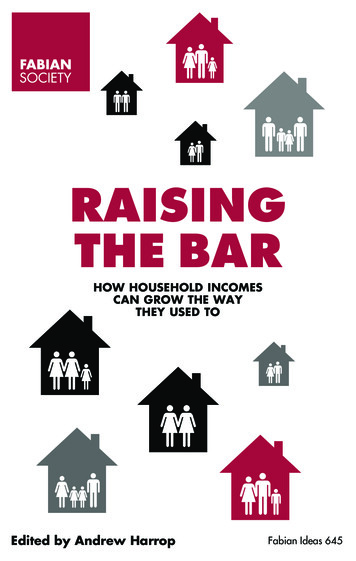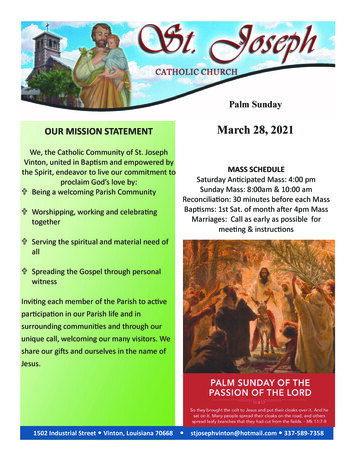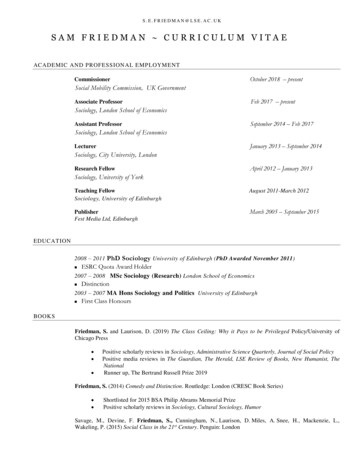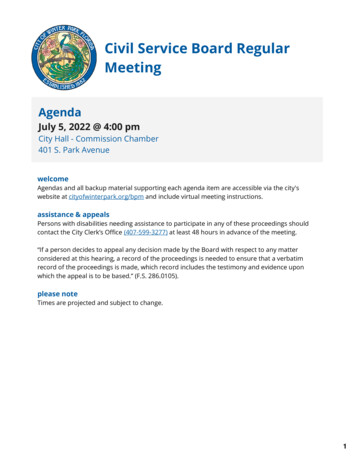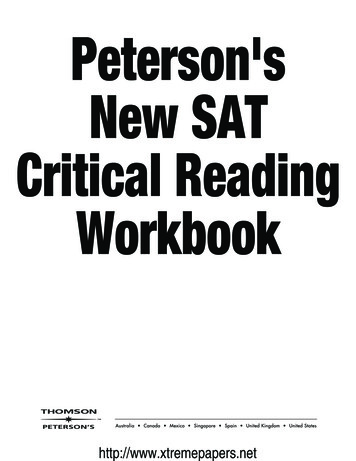
Transcription
http://www.xtremepapers.net
About Thomson Peterson’sThomson Peterson’s (www.petersons.com) is a leading provider of education information andadvice, with books and online resources focusing on education search, test preparation, and financialaid. Its Web site offers searchable databases and interactive tools for contacting educational institutions, online practice tests and instruction, and planning tools for securing financial aid. Peterson’sserves 110 million education consumers annually.For more information, contact Peterson’s, 2000 Lenox Drive, Lawrenceville, NJ 08648; 800-3383282; or find us on the World Wide Web at www.petersons.com/about. 2005 Thomson Peterson’s, a part of The Thomson CorporationThomson LearningTM is a trademark used herein under license.Previous editions 2001Previously published as Peterson’s Exercises for the SAT.Editor: Wallie Walker Hammond; Production Editor: Teresina Jonkoski;Proofreader: Brett Bollman; Manufacturing Manager: Judy Coleman;Composition Manager: Melissa Ignatowski; Cover Design: Greg WuttkeALL RIGHTS RESERVED. No part of this work covered by the copyright herein may be reproduced or used in any form or by any means—graphic, electronic, or mechanical, including photocopying, recording, taping, Web distribution, or information storage and retrieval systems—withoutthe prior written permission of the publisher.For permission to use material from this text or product, submit a request online atwww.thomsonrights.comAny additional questions about permissions can be submitted by e-mail tothomsonrights@thomson.comISBN: 0-7689-1716-6Printed in the United States of America10 9 8 7 6 5 4 3 2 107 06 05
ContentsIntroduction1 About the SAT . 3Purpose of the SAT . 3Format of SAT I . 3Types of SAT Verbal Reasoning Questions . 4General Test-Taking Tips . 7How to Use This Book . 102 Diagnostic Critical Reading Test . 15Answer Key . 21Explanatory Answers . 22Critical Reading Practice3 Sentence Completions . 27What Is a Sentence Completions Question? . 27How to Answer Sentence Completions Questions . 28Pretest . 33Explanatory Answers . 34Level A Sentence Completions Exercises . 35Level B Sentence Completions Exercises . 45Level C Sentence Completions Exercises . 55Level D Sentence Completions Exercises . 65Answer Key . 75Explanatory Answers . 794 Critical Reading . 119What Is Critical Reading? . 119Types of Critical Reading Questions . 119Pretest . 126Explanatory Answers . 130Level A Critical Reading Exercises . 131Level B Critical Reading Exercises . 141Level C Critical Reading Exercises . 151Level D Critical Reading Exercises . 157Answer Key . 167Explanatory Answers . 170
ivContentsPractice Critical Reading TestsCritical Reading Test 1 . 185Critical Reading Test 2 . 191Critical Reading Test 3 . 197Critical Reading Test 4 . 203Answer Key . 209Explanatory Answers . 210AppendixA Helpful Word List . 219Vocabulary: Does It Matter? . 219The Six Best Vocabulary-Building Tips for the SAT . 220www.petersons.com
IntroductionPREVIEW PREVIEW1About the SAT2Diagnostic Critical Reading Test
1About the SATPURPOSE OF THE SATThe SAT is offered by The College Board to high school students. Wellover 2,000 colleges and universities in the United States and Canada require their applicants to take the test. Since the SAT is a standardized examination that is consistent in difficulty and format, it allows colleges tocompare the abilities of students from different high schools. According tothe College Board, the SAT is designed to measure your aptitude for college work.The SAT is now divided into two separate types of exams designatedSAT I and SAT II. SAT I tests critical reading, mathematical reasoning,and writing skills—your ability to understand what you read, use language effectively, reason clearly, apply fundamental and advanced mathematical principles to unfamiliar problems, and use standard writtenEnglish. SAT II tests mastery of specific subjects essential to academicsuccess in college.FORMAT OF SAT ISAT I is a three-hour and forty-five minute, mostly multiple-choice examination divided into sections as shown in the chart on the following page.One of the sections is experimental. The nonexperimental sections makeup the scores that colleges use to evaluate your application.The critical reading sections test critical reading and vocabulary skills.The mathematical sections cover arithmetic, algebra I and II, geometry,and other expanded math topics. The formulas you need will be given inthe test instructions; you are not required to memorize them.The experimental section of SAT I may test critical reading or mathematics. Your score in this section does not count; the results are used solelyby the test-makers in devising future tests. The order of the sections of SATI is not fixed. You will not be told which section is the experimental one, soit is important that you do your best on every section.The following is a schematic representation of a typical SAT I. Whilethe ordering of the sections—as well as the timing and number of questions within each section—may vary, the format will adhere to this basicscheme.3
4IntroductionTYPICAL FORMAT OF SAT ISectionTime AllowedSECTION 1: CRITICAL READINGSentence CompletionsCritical ReadingSECTION 2: MATHEMATICSMathematicsSECTION 3: CRITICAL READINGCritical ReadingSECTION 4: MATHEMATICSMathematicsSECTION 5: CRITICAL READINGSentence CompletionsCritical ReadingSECTION 6: MATHEMATICSStudent-Produced ResponsesSECTION 7: WRITINGEssay25 min.25 min.20 min.20 min.25 min.25 min.35 min.TYPES OF SATVERBAL REASONING QUESTIONSThe verbal sections of the SAT I test vocabulary, verbal reasoning, and theability to understand reading passages. These skills are measured by meansof two question types:1. Sentence Completions2. Critical Reading, both short and long passagesSentence CompletionsThis type of question tests your ability to recognize relationships amongthe parts of a sentence so that you can choose the word or words that bestcomplete each sentence.www.petersons.com
About the SATExample:Conditions in the mine were ----, so the mine workers refused toreturn to their jobs until the dangers were ----.(A) filthy . disbanded(B) hazardous . eliminated(C) deplorable . collated(D) conducive . ameliorated(E) illegal . enhancedThe correct answer is (B). The workers wanted the hazardous conditionseliminated.Critical ReadingThis type of question tests your ability to read and understand passagestaken from any of the following categories: humanities, social sciences,natural sciences, and fiction or nonfiction narrative.Based upon reading selections ranging from 200 to 850 words, criticalreading questions may require you to Recognize the meaning of a word as used in context Interpret specific information presented in the passage Analyze information in one part of the passage in terms of informationpresented in another part of the passage Evaluate the author’s assumptions or identify the logical structure ofthe passageSome reading selections consist of a pair of passages that present differentpoints of view on the same or related subjects. The passages may supporteach other, oppose each other, or in some way complement each other.Some questions relate to each passage separately and others ask you tocompare, contrast, or evaluate the two passages.www.petersons.com5
6IntroductionExample:Private enterprise is no stranger to theAmerican prison. When the United Statesreplaced corporal punishment with confinement as the primary punishment for(5)criminals in the early nineteenth century,the private sector was the most frequentemployer of convict labor. Prisoners weretypically either leased to private companies who set up shop in the prison or used(10) by prison officials to produce finishedgoods for a manufacturer who supplied theraw materials to the prison. The formerarrangement was called the contract system, while the latter came to be known as(15) the piece-price system. In both instances,a private company paid the prison a feefor the use of prison labor, which was usedto partially offset the expense of operating the prison. Blatant exploitation of in(20) mates sometimes developed as aconsequence of these systems.(25)(30)(35)(40)Opposition to the use of prison laborfrom rival manufacturers and from thegrowing organized labor movement beganto emerge in the latter part of the nineteenth century as more and more prisoners were put to work for the private sector.Opposition reached a peak during theGreat Depression when Congress passeda series of laws designed to prohibit themovement of prison-made goods in interstate commerce, thus insuring that theseproducts would not compete with thosemade by outside labor. Many state legislatures followed suit, forbidding the openmarket sale or importation of prison-madegoods within their borders and effectivelybarring the private sector from the prison.As a consequence, prison-based manufacturing operations became state-owned and-operated businesses, selling goods in ahighly restricted market.1. Prisons stopped producing readily available goods due to all of thefollowing except(A) laws passed by state legislatures(B) laws passed by the Congress of the United States(C) opposition from organized labor(D) dissatisfaction of the prisoners(E) opposition from rival manufacturersThe correct answer is (D). This question requires you to apply information given in the passage. There is no mention of prisoner dissatisfaction,so (D) is correct. Choice (A) is mentioned in lines 34–38, choice (B) ismentioned in lines 29–34, and choices (C) and (E) are mentioned in lines22–26.2. In the arrangement known as the “contract system”(A) companies set up shop inside a prison and used prisoners forlabor(B) manufacturers supplied raw materials to the prison(C) all of the prisoners signed a contract to produce a certainamount of goods(D) prisoners with suitable skills would contact the companies(E) exploitation inevitably ensuedThe correct answer is (A). This question requires you to interpret details.In lines 8–9, the contract system is defined as a system in which prisonerswere “leased to private companies who set up shop in the prison.”www.petersons.com
About the SAT3. According to the passage, which of the following was instrumental inthe development of the private sector in prison?(A) Seed money from the federal government(B) The replacement of corporal punishment with confinement(C) The crudeness of the original prison system(D) The constant exploitation of the prisoners by manufacturers(E) The pieceprice and contract systemThe correct answer is (B). This question requires you to evaluate information. Choice (B) is stated in the second sentence of the passage.4. Which of the following statements can be inferred from the passage?(A) There is no longer any private sector work done in prisons.(B) Legislatures are ready to repeal the previously passed prisonlaws.(C) Prison systems were once fully supported by the fees paid bythe private sector.(D) The Great Depression was caused by excessive prison labor.(E) Piece-price was more profitable than the contract system.The correct answer is (A). This question requires you to make an inference. Choice (A) follows from the last sentence of the passage.GENERAL TEST-TAKING TIPSThe SAT contains several critical reading sections. On a typical past SAT,the nonexperimental sections would contain 78 verbal questions. Of these,typically 19 would be sentence completions, 19 would be verbal analogies,and 40 would be critical reading questions.The SAT contains an experimental section.One of the sections of your SAT will be an experimental section. That is,the test-writers will be using it to try out new questions for future exams.The experimental section may contain either critical reading or math questions. You won’t be told which section is the experimental one, so you willneed to do your best on every section.Every section of the SAT has a time limit.You are allowed to work on a section only during the time set aside for thatsection. You cannot go back to an earlier section, and you cannot skip aheadto a later section. Since you only have one chance to answer the questionsin a section, make sure you use your time wisely.Learn to pace yourself to get your highest score.Your verbal SAT score is based on a formula that takes into account thenumber of questions you answer correctly and the number of questions youanswer incorrectly. The formula is:www.petersons.com7
8Introduction1Number Correct – ( 4 Number Incorrect) Raw ScoreQuestions left blank do not affect your score. For example, a studentwho answers a total of 55 verbal questions correctly and 20 incorrectly(leaving 5 blank) would have the following raw score:1Correct – ( 4 Incorrect) Raw Score155 – ( 4 (20)) 50The raw score is then converted to a scaled score (the 200 to 800 scale)using another formula. To give you some idea of how many answers youneed for a certain score, here is a partial listing of raw score/scaled scoreconversions:Verbal Raw ScoreVerbal Scaled Score(0 to 80)8075605030(200 to 800)800750610540470Practice under timed conditions to find the best balancebetween speed and accuracy.Since your critical reading score is based on the number of questions youanswer correctly, less an adjustment for questions you answer incorrectly,you can get your maximum score only if you learn to balance speed withaccuracy. You can’t afford to go so fast that you miss a lot of questions dueto carelessness. On the other hand, you can’t afford to be so careful thatyou just don’t get to a lot of questions.Don’t waste time on specific questions.Each critical reading question counts exactly one point toward your rawscore. The easiest question on the test counts one point, and the hardestquestion counts one point. So don’t waste time working on a question thatyou can’t seem to solve. When you reach the point at which you realizeyou’re not making progress, leave that question. Come back to it later ifyou have time.Sentence completions are arranged in increasing order ofdifficulty.The questions get harder as you go along. The first question will be oneanyone can answer. By the middle of the section, you will find some questions that are difficult. By the end of the section, you will encounter somevery difficult questions. Thus, work as quickly as you can through the earwww.petersons.com
About the SATlier questions in a section; you can use the extra time to answer the difficultquestions that come later.You can vary your order of attack within a section.Within the time limit, you can attack the questions in the section in anyorder you want to. You could do analogies first even though they are notpresented first. Is there any advantage to doing the problems out of order?Maybe— critical reading questions are based on a selection that may be aslong as 800 words. You can’t answer the critical reading questions untilyou’ve done the reading. Wouldn’t it be a shame to read a critical readingselection and run out of time before you have a chance to answer the questions? So, if you are having a problem with time, make sure that you answer all of the short questions (analogies and sentence completions) beforeyou tackle the critical reading. But be careful that you mark your answersheet correctly!Bring a watch to the exam.Your exam room may not have a clock. To keep track of the passing time,make sure that you bring your own timepiece. You don’t have to have afancy stop watch; a simple watch will do.If you are able to eliminate one or more answers to a question,you should guess.In the scoring system, the guessing penalty is calculated to eliminate theadvantage of random guessing. It should not affect educated guessing. Toprove this to yourself, ask what would happen if you guessed at random on20 questions. Since there are five answer choices to each question, youwould get one out of every five questions right and miss the rest. Since youwould get four questions right and miss 16, your raw score would be:1Correct – ( 4 Incorrect) Raw Score14 – ( 4 (16)) 0A completely neutral result. But now think about what would happen ifyou make educated guesses. Assume that in each of the 20 questions youcan eliminate even just one answer choice. That would leave four ratherthan five choices for each question, so you would expect to get one out ofevery four correct. Since you would get five questions right and miss only15, your raw score would be:1Correct – ( 4 Incorrect) Raw Score115 – ( 4 (15)) 1 4That number will be rounded off to the nearest integer, so your net gainwould be 1 on the raw score. And that could make you jump 10 points onthe scaled score, e.g., from 510 to 520 or from 630 to 640!www.petersons.com9
10IntroductionMake sure you mark the answer spaces completely and neatly.The SAT, for the most part, is a machine-graded exam. You enter your responses on an answer sheet by darkening ovals. Be careful! The machinecan only read what you’ve put down. If you make a mistake in markingyour answer sheet, even though you know the right answer, the machinewill read a wrong answer.Mark your answers in groups.Instead of working a question and marking an answer and working a question and marking an answer and so on, work a group of problems in yourtest booklet, and then mark your answers. With this system, there is lesschance that you will make a mistake as you enter your answers.Create a record-keeping system for yourself.You’ll find that there are some questions you can answer easily, others thatyou can’t answer immediately but think you can if you come back later anddo some more work, and still others that you can’t answer at all. You’llprobably be going back and forth a good deal. To help keep track of whatyou have done and what you haven’t done, create for yourself a system ofsymbols. For example, circle the answer you think is correct. Or if youaren’t able to answer a question definitely and intend to come back to itlater, put a question mark by the number of that question and put an “x”over any choice you have already eliminated.HOW TO USE THIS BOOKThis is not an ordinary SAT exercise book. Every test is graded for difficulty so that you can pace yourself according to your needs. Level A questions are slightly easier than actual SAT questions; level B questions areapproximately equal in difficulty to real exam questions; level C questionsare more difficult; and level D questions are of varying degrees of difficulty. Level D tests have a difficulty level approximately equal to that of aregular SAT.If the equivalent score on the diagnostic test is below the level requiredby the college of your choice, you may need to improve your study skills oryour understanding of the exam or both. The diagnostic test’s explanatoryanswers will help you find out whether your vocabulary and critical reading skills are what they should be. In addition, by studying the test-takinghints preceding each section you will become more familiar with the actualexam format, which will in turn enable you to work on the questions in anefficient, orderly way. The guidelines below should be followed for maximum results:1. Take and score the diagnostic test.2. Analyze your results to see how well you did in each question category.www.petersons.com
About the SAT3. Study the advice given, as well as the pre-test and analysis in eachcategory.4. Apportion your time for the drill tests according to the amount of troubleyou had in each category.5. Retest yourself periodically between the time you take the diagnostictest and the time you plan to take your SAT. Use the three practicecritical reading tests. If, for example, there are nine weeks from thetime you took your diagnostic test until your SAT, you should planon taking the practice critical reading tests in the third, sixth, andninth weeks.Your scores should keep climbing as continued practice gives you confidence and experience.www.petersons.com11
Diagnostic Critical Reading TestAnswer SheetDirections: For each question, darken the circle that corresponds to your answer choice. Markonly one circle for each question. If you change your mind, erase your answer tersons.com
2Diagnostic CriticalReading Test30 Questions 30 MinutesDirections: Each of the following questions consists of an incomplete sentence followed by fivewords or pairs of words. Choose that word or pair of words which, when substituted for theblank space or spaces, best completes the meaning of the sentence, and mark the letter of yourchoice on your answer sheet.3. You have a(n) ----; the test has beenpostponed for a week.(A) absence(B) holiday(C) request(D) assignment(E) reprieveExample:In view of the extenuating circumstancesand the defendant’s youth, the judgerecommended ----.(A) conviction(B) a defense(C) a mistrial(D) leniency(E) life imprisonment4. The sheik’s wealth was a matter of ----;nobody had the least idea of how much hepossessed.(A) conjecture(B) conjunction(C) divinity(D) obloquy(E) concerna b c d e1. Gregory’s face was ---- when he reportedthe loss of his ship.(A) vivid(B) somber(C) animated(D) pusillanimous(E) antiquated5. During the 1923 German inflation, therewas a ---- of paper currency; it took awheelbarrow to transport enough moneyto buy a suit.(A) shortage(B) supply(C) dearth(D) transfer(E) plethora2. Since his clothes were soaked, his story offalling into the creek seemed ----.(A) incredible(B) absurd(C) predictable(D) plausible(E) remarkable15
16Introduction6. Trespassing on private property is ---by law.(A) proscribed(B) warranted(C) prescribed(D) eliminated(E) forgiven7. Since you have just made a(n) ---- sale, thisis a(n) ---- time to ask for a raise.(A) meager . excellent(B) ostentatious . precipitous(C) impressive . opportune(D) plausible . preposterous(E) pernicious . reprehensible8. People are ---- to confess such anxieties forfear of appearing ----.(A) reluctant . virtuous(B) eager . recondite(C) constrained . derelict(D) reticent . weak(E) hesitant . prudent9. They are a(n) ---- couple who cultivatemany friendships among ---- people.(A) gratuitous . frivolous(B) indolent . impeccable(C) gregarious . diverse(D) insidious . intrepid(E) solicitous . laconic10. A person who commits a wrong may berequired to ---- his property as a penalty.(A) confiscate(B) destroy(C) forfeit(D) assess(E) sell11. When the desk was placed facing thewindow, she found herself ---- from herwork by the activity on the street.(A) distraught(B) destroyed(C) distracted(D) decimated(E) diminishedwww.petersons.com12. He said he didn’t get the job done becausehe was incapacitated; in truth, he was ---and slothful.(A) indigent(B) indolent(C) indulgent(D) insipid(E) incapable13. The “policemen” turned out to be clowns;the setup was a ----.(A) stickup(B) mystery(C) mix-up(D) fracas(E) hoax14. During colonial winters in America, therewas a ---- in every ----.(A) fire . hearth(B) stoker . pot(C) flintlock . chimney(D) teepee . stockade(E) blizzard . storm15. Since she was so hardworking, Jillian’sparents never had to ---- her for being ----.(A) chide . industrious(B) ride . superfluous(C) punish . independent(D) chide . slothful(E) commend . intransigent
Diagnostic Critical Reading TestDirections: Each reading passage below is followed by a set of questions. Read the passage andanswer the accompanying questions, basing your answers on what is stated or implied in thepassage. Mark the letter of your choice on your answer sheet.Questions 16–21 are based on the followingpassage.Nancy Langhorne was born in the UnitedStates in 1879. She moved to England, marriedViscount Astor, and became the first womanever to sit in the House of Commons, a positionshe held from 1919 to 1945. As Lady Astor, herpolitics were often questionable—she wasamong those who sought to appease theFascists in the 1930s—but her door-openingrole for women in politics made her animportant figure. The following comments areexcerpted from a 1922 address at Town Hall inNew York City.My entrance into the House of Commonswas not, as some thought, in the nature ofa revolution. It was an evolution. My husband was the one who started me off onthis downward path—from the fireside to(5)public life. If I have helped the cause ofwomen, he is the one to thank, not me.A woman in the House of Commons! Itwas almost enough to have broken up the(10) House. I don’t blame them—it was equallyhard on the woman as it was on them. Pioneers may be picturesque figures, but theyare often rather lonely ones. I must sayfor the House of Commons, they bore their(15) shock with dauntless decency. No bodyof men could have been kinder and fairerto a “pirate” than they were. When youhear people over here trying to run downEngland, please remember that England(20) was the first large country to give the voteto women and that the men of Englandwelcomed an American-born woman inthe House with a fairness and a justicewhich, at least, this woman never will(25) forget.Now, why are we in politics? What is itall about? Something much bigger thanourselves. Schopenhauer was wrong in(30)(35)(40)(45)(50)(55)(60)nearly everything he wrote aboutwomen—and he wrote a lot—but he wasright in one thing. He said, in speaking ofwomen, “the race is to her more than theindividual,” and I believe that it is true. Ifeel somehow we do care about the raceas a whole, our very nature makes us takea forward vision; there is no reason whywomen should look back—mercifully wehave no political past; we have all the mistakes of sex legislation with its appallingfailures to guide us.We should know what to avoid, it is nouse blaming the men—we made themwhat they are—and now it is up to us totry and make ourselves—the makers ofmen—a little more responsible in the future. We realize that no one sex can govern alone. I believe that one of the reasonswhy civilization has failed so lamentablyis that it has had a one-sided government.Don’t let us make the mistake of ever allowing that to happen again.I can conceive of nothing worse than aman-governed world ex
The critical reading sections test critical reading and vocabulary skills. The mathematical sections cover arithmetic, algebra I and II, geometry, and other expanded math topics. The formulas you need will be given in the test instructions; you are not required to memorize them. The experimental section of SAT I may test critical reading or math-
